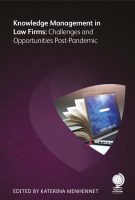
Leadership is not billable or recoverable. Therein, lies the fundamental challenge of leading a Law firm and managing your own career as a lawyer. In addition, a partnership is one of the most challenging organisations to direct and manage there is often no transparently demarcated power structure. These factors combined with “Autonomy” (page 12) of offices, departments, sectors and teams and “…autonomously-minded individuals.” (Page 15) make leadership demanding.
This Special Report, “The Lawyer as Leader: how to Own your Career and Lead in Law Firms” by Antonin Besse gives a comprehensive and authoritative guide on how to overcome these challenges, whether leader of a firm or personally as an individual lawyer. Antonin delivers on his statement: “This Special Report will examine how to harness autonomy for good through self-leadership; how to empower others through effective leadership; and how to overcome individualistic tendencies in order to foster motivation, build strong teams, promote collegiality and encourage greater profitability.” (Page 13).
This Special Report focusses on self-ownership, self-development and self-management. This makes it wonderfully empowering, because it gives the readers the insight, the information and the skills to take responsibility for their own pro-active development, rather than being buffeted by random pressures generated by a “Let’s see what happens” (page 8) attitude. It aims to change the question from “What’s expected of me?” (page 8 + page 24) to “… proactively shaping the career you want” (page 8).
The value of the Special Report is that it takes into account the environment of law firms and the characteristics of lawyers “… autonomous, task- and target-focused individuals…”(page 31) “… naturally under-confident overachievers” (page 32) so that the advice is not a series of idealised aspirations, but rather an action plan towards an achievable reality.
Lawyers need the guidance that this Special Report gives, now, because of rapid change. Developments globally, environmentally, technologically and in client expectations are generating a need for a proactive and flexible approach from law firms and lawyers. There is an excellent section on “Business awareness” (page 40/41) asking “What’s driving the client?” and responding, “The short answer is: value for money”. Lawyers now must anticipate, be abreast of and responsive to all the pressures which affect their clients and adjust the delivery and costs of their legal services accordingly.
In addition to the complexity of these external vicissitudes, there is a generational change in which many millennials are aspiring to a greater work-life balance, content not necessarily to become a partner.
“The Lawyer as Leader” provides an analysis of all these changes and their implications. It gives practical advice, techniques and tips on how to lead a law firm that anticipates, adapts and responds to these changes. It also clarifies how individual lawyers need to be their own leader in order to make the most of these changes and achieve greater “Wellbeing” (chapter VII, page 93).
Antonin writes in such a way that you feel that he is talking to you personally. You also feel that he is actively listening to your ideas and responses, because he seems to anticipate questions arising, and answers then in them in the following paragraph. His style is easy to read, structured in short sentences and bullet points. His anecdotes are enlightening, for example “How not to lead” and “How to engage through great communication” (page 90).
Key quotations, which are written in green on a white background and scattered throughout the book, are in themselves motivational, for example “Don’t try to impress them. Let them impress you. They will love you for it” Olivia Fox Cabane, referring to the need to listen in networking as opposed to talk (page 38). Listening is a key thread throughout the Special Report.
Every word demonstrates Antonin’s experience of more than 30 years as an international commercial lawyer and senior partner in a Magic Circle firm. His tone is positive, supportive and constructive. “For those of us who are not natural optimists, the good news is that optimism and motivation can be learned” (Page 64) and “The good news for those who are not naturally emotionally intelligent is that it can be acquired to a great extent by learning and self-reflection, and by practising its precepts.” (Page 68)
The presentation of the Special Report makes it enjoyable to handle, light and easy to carry around and pleasant to absorb. The right-hand margins are wide, which means the reader can make notes and references easily. The detailed Contents Page gives a comprehensive summary of the approach, structure and significant issues that need to be considered for leadership and self-leadership. The comprehensive headings and subheadings give good guidance and an easily accessible reference to key points for later revision.
The theme of the Special Report is to give practical guidance on the key requirements for leadership and self-leadership. Very broadly, each of the 7 chapters, and the subheadings, give some background, key principles, skills, knowledge and requirements and then follows up with practical ways of implementing the theory; the ideas and suggestions. So, for example Chapter III “Lawyers as leaders” analyses “… The heart of good leadership: to formulate ideas and transmit them in a way that engenders cooperation.” (Page 23). It then looks at the key elements required of a good leader, and then how to develop these skills and techniques.
There is a particularly eye-catching method of giving prominence to the practical advice by highlighting it in a green box. This will be particularly useful for further reference when desiring to apply these in practice. For example, SMART goals (page 27); “Conducting a ‘difficult’ feedback conversation” (page 34-35); “Effective goal-setting – key factors” (page 57); “Prochaska’s Stages Of Change Model” (page 67) applied in this case to coaching; “the Johari window” (page 72); “Mapping the context – questions for the coachee” (page 73); “Balancing the energy budget - the questions to ask” (page 93).
The references throughout the report provide an added dimension and depth to it. Quotations from Sun Tzu, “The Art of War” give a dynamic and motivational start to chapter III “Lawyers as leaders”. A number of the references are to psychology, emotional intelligence and motivation publications, which are not areas usually referenced in a book for lawyers. This reflects the increasingly open recognition of the impact and importance of “… work-life balance, wellbeing and career choice” (page 95) in the legal profession, although Antonin observes that “… vulnerability is perceived as a weakness.” (Page 31). Chapter 7 is devoted to Wellbeing (page 93-96) with section 4 headed “Fear and loathing in law firms – a plea for psychological safety”. (Page 95)
The three Appendices are a hugely value-enhancing aspect of this Special Report. They are detailed and enable the reader to apply everything that they have read to their own personal situation, easily and succinctly. What is also impressive about the Appendices is that Antonin demonstrates in practice everything that he writes about. For example, the Appendices feel like they are a personal coaching lesson from him. He also applies SMART targets to every action he suggests.
The Appendices comprise comprehensive templates. Each template either contains examples of the questions to be asked in order to complete it, for example, SWOT analysis in Appendix 1 (page 97). Or, the template includes detailed examples of the type of content to include in it, for example Appendix 1 “What kind of leader am I?” (page 98). Appendix 2: on Career planning gives extensive examples and comments in reply to the questions arising from “Where am I now?”, Which is subdivided into “as a person”; “as a professional”; and “clients and network” (page 100 – 102).
As well as considering career planning from a personal point of view, Appendix 2 also gives guidance on “Sample goals and action plan for refocusing practice” (page 106). Although this is a personal development plan for refocusing a personal practice, the template could be effectively applied to many law firms.
Perceptive and thought generating questions in the table “Where next?” (Page 103) will help all lawyers to analyse where they are now, where they want to be and how to get there. The “Action plan template” (Page 104) is an excellent analysis of the key personal considerations.
Every table in every Appendix is enlightening and instructive. The template which is likely to be least familiar and the least comfortable for many lawyers, particularly at a more junior level, is that in Appendix 3: Project management (page 111 – 116). Project management is becoming an increasingly necessary and essential skill for all lawyers.
Efficient and effective project management is a fundamental to the success of many commercial law firm clients. Project management, using a structured and focused methodology, has been slowly and ofttimes reluctantly, incorporated into the management of all matters. This comprehensive and easy to understand series of tables and charts including “Sample resourcing and scheduling Gantt chart” (page 114-115) will be the essential leadership and management tool of any lawyer going forward at whatever level.
This Special Report is a personal and professional handbook for life.
Pippa Blakemore has been advising lawyers and law firms all over the world on how to win, keep and grow clients for more than 34 years. Pippa has written the popular book: “Networking for Lawyers: a pocket guide to building business relationships” (available from www.pep-partnership.co.uk). She has also written: “Law Firm Pitches & Tenders: Presenting to Win” published by Worldwide Legal Research” (http://www.legal-monitor.com/pitches-and-tenders). For further information contact Pippa on: pippa.blakemore@pep-partnership.co.uk
,





